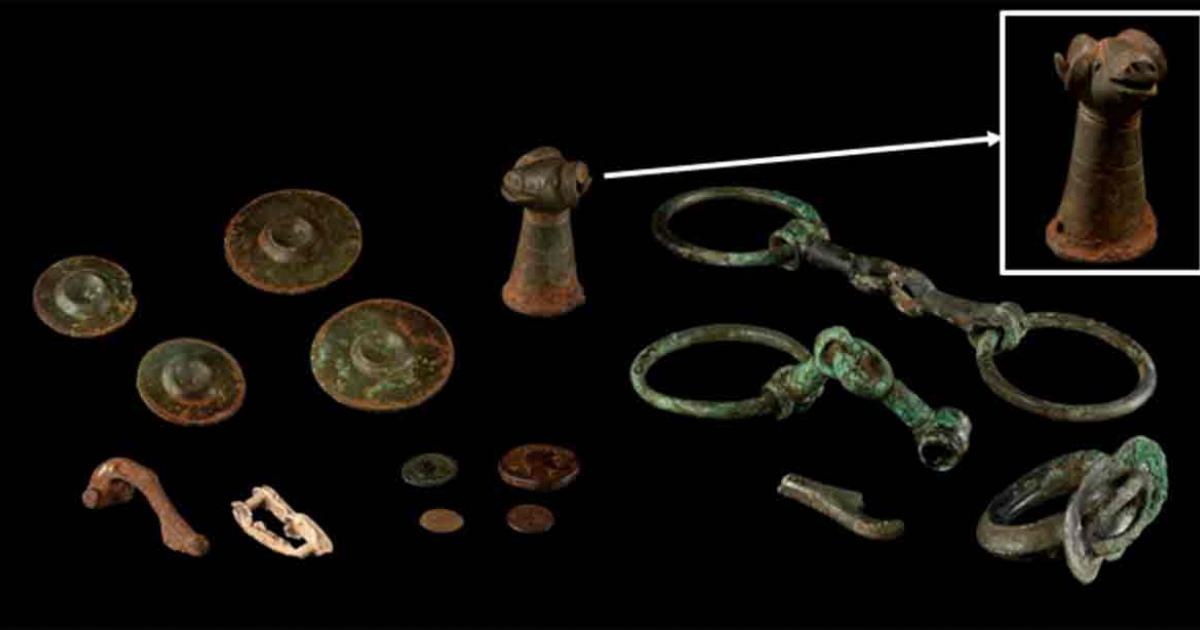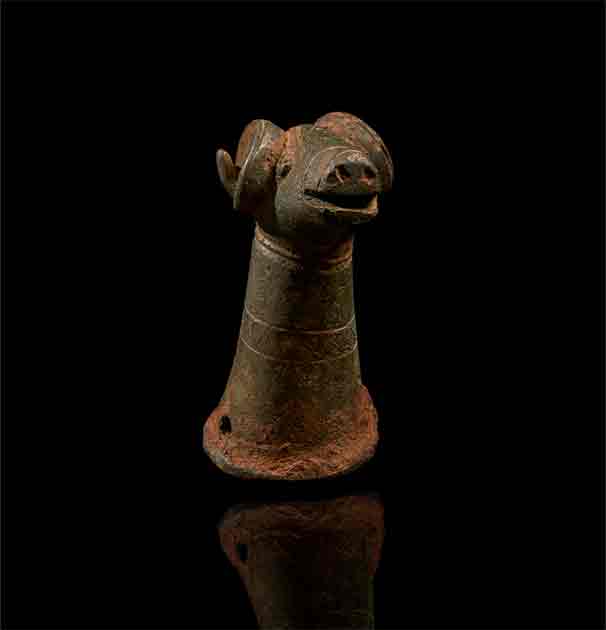
Roman Offerings at Sacred Spring Whisper of the Druids’ Last Stand
In a significant archaeological find, a collection of sixteen ancient artifacts dating back to the Iron Age and Roman periods has been officially declared treasure by H.M. Senior Coroner for North-West Wales, Ms. Kate Robertson. The announcement was made on Wednesday, February 28, 2024, casting a spotlight on a historic find that promises to rewrite the narrative of early British history.
A Metal Detectorists Dream
The discovery (Treasure Case 20.04) was made by Ian Porter on 4th March 2020 while metal-detecting on a field under pasture in Llanfair-Mathafarn-Eithaf Community, Anglesey. The find was first reported to Sean Derby, Finds Liaison Officer of the Portable Antiquities Scheme in Wales (PAS Cymru) based at Gwynedd Archaeological Trust. It was subsequently reported as a treasure find by expert archaeological curators based at Amgueddfa Cymru – Museum Wales.
The artifact group includes a number of Iron Age chariot fittings dating to the later first century AD and Roman cavalry fittings of similar date. These include parts of three bridle-bits, a terret (or rein-guide), a ram’s head fitting and a set of four harness discs known as phalerae.
- Roman Penis Pendant Found in Britain Declared a “National Treasure”
- UK Declared a Land Full of Hidden Treasure By British Museum

The hefty Copper Ingot mined nearby. (Museum Wales)
A large and complete Roman copper ingot weighing 45 pounds (20.5kg) was also discovered, probably smelted copper deriving from the nearby Roman copper mine at Parys Mountain.
The additional artifacts, all of Roman date, include a decorated brooch, four coins and a lead pot repair.
Sacred Offerings
The artifacts were all discovered near and around where a spring emerges in a boggy area of a modern field, liable to waterlogging. These unusual bronze, copper and lead artifacts are thought to have been gifted as repeated religious offerings around an ancient sacred spring source during the Late Iron Age and into the Romano-British period.
The chariot fittings, cavalry harness pieces and brooch were all placed around AD 50-120, around the time of, or soon after the invasion of Anglesey island by the Roman army in AD 60/61.
The coins and other artifacts suggest a continuing practice of votive gifting around the spring throughout the Roman period, the latest coin in the group being struck around AD 364-378.
The finder, Ian Porter, said:
“I was so excited when I found these items. To think that the last person who touched them lived almost two thousand years ago and it shows some of the history of the island".

Iron Ram’s head. (Museum Wales)
The Anglesey Druids Last Stand
The Isle of Anglesey, known to the Romans as Mona, has long been enveloped in tales of savagery and mysticism, primarily centered around its ancient Druid inhabitants. Historically depicted as the last bastion of paganism in Wales, the island's conquest in 77 AD by the Romans is often cited as the end of ‘barbaric’ Druidic practices. But recent discussions among historians suggest that this image of bloodthirsty Druids may have been a Roman exaggeration, propaganda to justify the brutal colonization of the British Isles.
- A Brief History of Roman Britain: A Land Transformed
- The Conquest of Anglesey and the Destruction of Druidism’s Last Stronghold
Located off the northwest coast of Wales and bordered by the Irish Sea, Anglesey's fertile valleys and strategic location made it an essential agricultural center and a stronghold of Druidic culture. This island, rich in megalithic burial chambers and standing stones, provides tangible evidence of its significant Neolithic and early Bronze Age presence. By 100 BC, Celtic traditions had firmly taken root, culminating in Anglesey's evolution into a revered Druidic sanctuary.
The Roman perspective, largely derived from accounts such as those of Julius Caesar following his 55 BC encounter, and Tacitus, paints Druidism in a dark light, highlighting practices like human sacrifice as abhorrent. However, these accounts are increasingly scrutinized for their potential bias and the possibility that they were part of a larger narrative strategy employed by the Romans to demonize the Druids, thereby legitimizing their own military campaigns.
The Romans' eventual suppression of Druidism on Anglesey marked a significant cultural shift, but the true nature and practices of the Druids remain a subject of debate. This reevaluation invites a deeper understanding of the clash between Roman imperialism and the indigenous cultures of the British Isles, challenging long-held perceptions and opening new avenues for historical research. As scholars continue to unearth and interpret evidence, the story of Anglesey and its Druids is far from closed, suggesting that what has been accepted as historical fact may, in truth, be a complex tapestry woven from narratives of conquest and resistance.
Roman Offerings Signifying the End of the Druids
Adam Gwilt, Principal Curator for Prehistory at Amgueddfa Cymru – Museum Wales said:
“This culturally mixed artifact group, containing both Iron Age chariot fittings and Roman cavalry fittings, is an important new find for the island. It was placed during or in the aftermath of the period of invasion of the island by the Roman army. This dramatic event is vividly captured by the Roman author Tacitus, writing about the strange first encounter between Roman soldiers and Druids on Anglesey. This group of gifted objects illustrates how watery locations, including the sacred lake site at Llyn Cerrig Bach, were seen as significant places for religious ceremony at this time of conflict and change.
The ram’s head fitting, probably a vehicle-fitting or staff-head is decorated in the late Celtic art style. It is a closely observed and quirky depiction of the ram and a likely future ‘star’ exhibit loved by many for Oriel Môn!”
Ian Jones, Building and Collections Manager at Oriel Môn, said:
“Since the discovery of the Iron Age artifacts from Llyn Cerrig Bach during the 1940s, Anglesey has long been associated with this important period in our history. This exciting new find from the island will enhance our understanding and knowledge, and Oriel Môn is pleased to collaborate with Amgueddfa Cymru and is eager to acquire it for our collection. The items themselves and nature of how they were deposited are of immense archaeological significance and will provide us with a great deal of potential in terms of display and interpretation. It will also offer fantastic outreach and educational opportunities. We understand that items from this period are of interest to our visitors, so this is thrilling news for us all.”
Oriel Môn museum and arts center has expressed an interest in acquiring this artifact group for its collection after it has been independently valued by via the Treasure Valuation Committee.
This article is largely a news release by Amgueddfa Cymru (Museums Wales) titled, ‘Religious Spring Find from Anglesey Declared Treasure’. The section on Anglesey Druids has been added by an Ancient Origins Editor for historic context.
Top image: The collection of 16 mostly Roman offerings found at the sacred spring site in Anglesey. Source: Museum Wales















